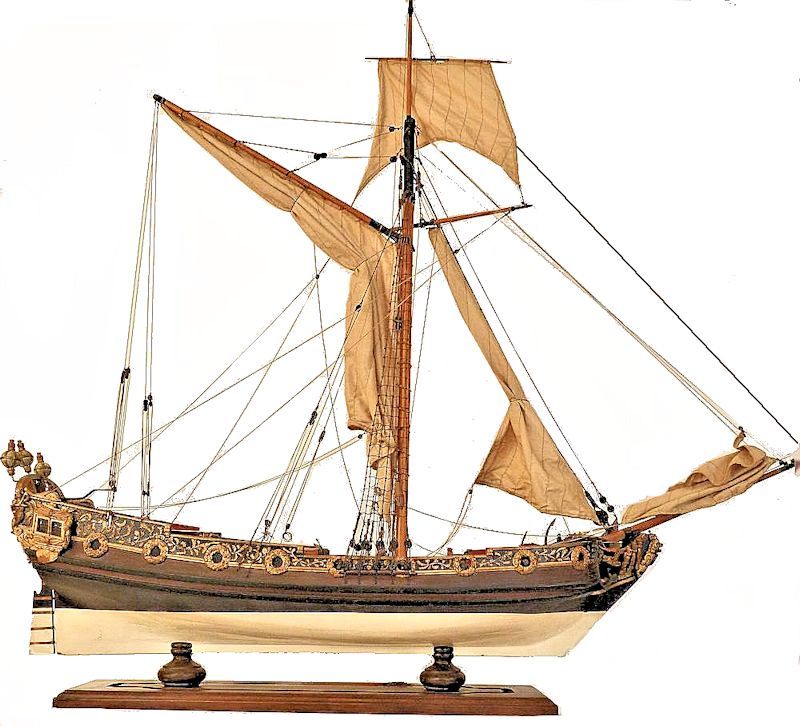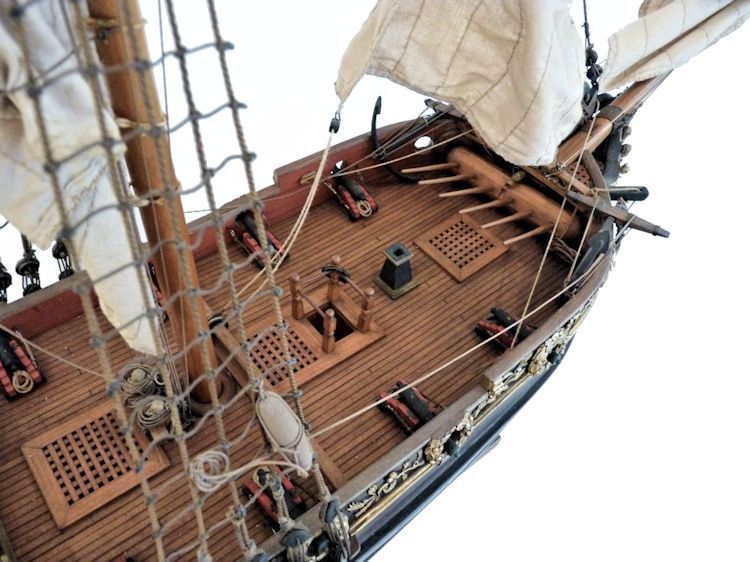ANTIQUE MODEL of UNNAMED BRITISH
8 GUN ROYAL CUTTER

Scratch Built Unnamed 18th Century Royal Model Model
size: 42” LOA (Length overall) 28” LOD (Length on deck) 38 ¼” from bottom of base
to top of mast 8” molded beam. Scale 1”= 2.5’ Ratio 1:30 Length of vessel 70 Feet
The
simple rig of this vessel with a a jib and foresail forward of the
single mast with two yards for a square topsail, and aft, a fore-and-aft gaff headed mainsail marks this vessel as a
British “Cutter” of the 18th Century. This is different than the contemporary two headsail single mast vessels of
today. Cutters were a native British design that became popular in the middle of the 18th Century. The largest group were
68 ft. long, 111 tons and were crewed by 40 officers and men. They were typically armed with ten 18 pound carronades. and
were used to transport officers and crew between the various ports and to perform dispatch services as a courier. During time
of war, they were used by the Royal Navy in large numbers to hunt down the privateers that swarmed in the Channel and North
Sea. Similarly, large numbers of them were used by the revenue services for patrolling the coastline in search of smugglers.
This model has
eighteen large, ornate gold wreath embellishments, consisting of ten that are open though the bulwarks,
but house only 4 cannons on each side*, and eight wreaths which are decorative. At the bow is a crowned lion figurehead
with a crest on its chest. This royal shield also appears on the transom with a knight’s helmet above,
and a similar crest over the captain’s gallery indicates the ship was owned by Royalty and had a more important
purpose. * 2 cannons may be moved to the open ports at the bow to serve as “Bow Chasers”. Crossed
Crossed
flags and royal shield over the captain’s gallery starboard light.It
is unfortunate that the maker did not provide her name, but research has discovered that King William III (1650-1702) had a similar vessel named HMS Mary that was launched in 1690
and saw service under a variety of rigs including that of a cuter until 1816. A remarkable record of longevity.
 THE HMS MARY: Model scale: 1:32. A contemporary full hull
THE HMS MARY: Model scale: 1:32. A contemporary full hull
model of King William III Royal Yacht, HMS Mary with a ketch rig, (circa 1690), built in the Navy Board style. Model
is decked and complete with a cutaway of her bottom showing her ribs. Mary was rebuilt in 1727 at Deptford Dockyard. She then
measured 76 ft 6 in long along the gun deck; 61 ft 6 in along the keel; with a beam of 22 ft 4 in and a hold depth of 9 ft
8 in. She was armed with eight 3-pounder guns, and had a complement of 40 men. Over her years of service she carried a variety
of rigs which included that of a cutter and full rigged ship. She was finally broken up in 1816 after 127 years service.
 Left: Coat of arms on transom has knight’s helmet.
Left: Coat of arms on transom has knight’s helmet.
Right: COA of King William III (1650 – 1702) The
close-up of the stern’s coat of arms pictured above shows a crowned lion on the viewer’s left, then a knight’s
helmet and a unicorn to the right. The same coat of arms also appears over the port and starboard captain’s
cabin lights. The lettering on the scroll reads 1004 on the left and illegible on the right. The coat
of arms on the right is that of King William III, (1650-1702). The framed carving is much more distinct.

 Top: Stern view or Royal Yacht model.
Top: Stern view or Royal Yacht model.
Lower: Looking aft from the gun deck. Note the 3 round stern lights
CONSTRUCTION
DETAILS: This carefully handcrafted model of a royal British cutter has a midnight black hull with a heavy
longitudinal rubbing strake and white bottom, and wood decks. The model sits on two large turned Walnut pedestals
which rest on a grooved Walnut base. The
rig consists of a long bow sprit carrying the jib, then a forestaysail and next aft the mast with a spar for a square
sail for downwind work. A large boomless mainsail is hanked to the mast and is headed by a gaff. All the sails except
the square topsail are in a furled position. The authentic
looking light tan sails have the look of age. The panels are machine stitched. As a point of reference, sewing machines were
invented by the Englishman, Thomas Saint in 1790, and their use spread quickly during the Industrial Revolution.
The
spars, mast and deck are stained and the inside of the bulwarks are painted red. The eight cannons are made of wood with painted
black barrels and red carriages. No seams are showing so the hull most likely is of block construction. The maker’s
attention to detail is shown by the tiny brass hinges on the side opening hatches in the “well” to
small, little, lamps made from wire for entering the officer’s quarters at night. Worth special mention are the two
transverse round timbers that go from beam to beam which serve as travelers. One is for the mainsail aft on the poop
and other is forward of the mast tending to the foresail. The ship is steered by a simple tiller at the
poop. No binnacle is fitted which may be an oversight. The large wood octagonal windlass at the forepeak has six levers
and was used to raise and lower the two large old style iron anchors with wood stocks, one rigged to the cathead
on each side.
 Two views of the foredeck.
Two views of the foredeck.
The lower showing details of the large octagonal windlass and black bilge pump There
are carefully made rope fenders hanging from the shrouds and lines and sheets are tied to tiny wood cleats. The
three large round stern lights have a red crown at their tops and are used as running lights for operating at night. Details show ladder to the Well deck and the
Details show ladder to the Well deck and the
end of the tiller caped in gold
PROVENANCE: Purchased in England
around 1985 from a London antiques dealer.
 Detail of the cutwater and crowned lion figurehead
Detail of the cutwater and crowned lion figurehead
 The portside of the Royal Cutter rigged ship model
The portside of the Royal Cutter rigged ship model
This carefully crafted, fully detailed model of a British Royal Cutter Rigged Ship is
Worthy of the most discriminating collector! CONDITION:
The model is in excellent condition considering its age. There is a 10 1/2 inch varnished spar with a continuous line
from one end to the other and coiled line at the end that has remnants of glue. The oil painting of the HMS Mary shows this
spar rigged under the bowsprit. There is no associated glue mark under the model’s bowsprit so it was
decided to leave it as we found it. Recent repairs have been made to the flagstaff on the bowsprit, one round light at the
stern and repairing a broken tiller. Everything else is without exception.
